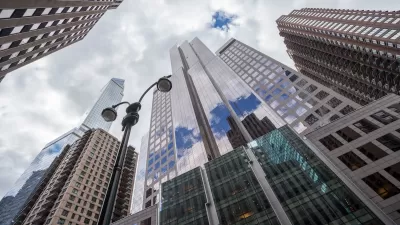A drop in demand for retail space began well before the seismic shifts of the pandemic.

In an article for Slate, Leah Brooks and Rachel Meltzer describe how the retail vacancy crisis began well before the COVID pandemic that accelerated it.
According to the authors, “Since 2012, almost a decade before we can attribute any decline to COVID, the amount of newly leased retail square feet flatlined and even declined in some cities. Also since 2012, retail rents have flattened or declined, and retail spaces sit empty longer between tenants.”
The article asserts that most cities’ zoning codes call for too much retail, leading to inevitable vacancies. This is in part “Perhaps because zoning for ground-floor retail is practically an act of faith among urban planners,” who operate on the belief that mixed-use zoning with ground-floor retail leads to vibrant, walkable neighborhoods. “However, the benefits from this type of planning are nullified when those storefronts sit vacant. Streetscapes pockmarked with dark windows and sidewalks with less foot traffic and fewer eyes can invite illicit and unsafe activity and may even suppress demand for living near those corridors.”
As online shopping and remote work continue to grow, there is no foreseeable resurgence in brick-and-mortar retail, the authors argue. Planners should focus on concentrating retail near transit hubs and mixed-use developments while allowing for residential conversions of spaces where it makes sense.
FULL STORY: Cities Planned Their Way Into the Retail Vacancy Crisis

Alabama: Trump Terminates Settlements for Black Communities Harmed By Raw Sewage
Trump deemed the landmark civil rights agreement “illegal DEI and environmental justice policy.”

Planetizen Federal Action Tracker
A weekly monitor of how Trump’s orders and actions are impacting planners and planning in America.

Why Should We Subsidize Public Transportation?
Many public transit agencies face financial stress due to rising costs, declining fare revenue, and declining subsidies. Transit advocates must provide a strong business case for increasing public transit funding.

Understanding Road Diets
An explainer from Momentum highlights the advantages of reducing vehicle lanes in favor of more bike, transit, and pedestrian infrastructure.

New California Law Regulates Warehouse Pollution
A new law tightens building and emissions regulations for large distribution warehouses to mitigate air pollution and traffic in surrounding communities.

Phoenix Announces Opening Date for Light Rail Extension
The South Central extension will connect South Phoenix to downtown and other major hubs starting on June 7.
Urban Design for Planners 1: Software Tools
This six-course series explores essential urban design concepts using open source software and equips planners with the tools they need to participate fully in the urban design process.
Planning for Universal Design
Learn the tools for implementing Universal Design in planning regulations.
Caltrans
Smith Gee Studio
Institute for Housing and Urban Development Studies (IHS)
City of Grandview
Harvard GSD Executive Education
Toledo-Lucas County Plan Commissions
Salt Lake City
NYU Wagner Graduate School of Public Service





























